The Westfield Sydney to Melbourne Ultra-Marathon was made famous by a most unlikely hero in 1983.
A 63-year old potato farmer, Cliff Young – who trained in gumboots – shuffled his way down the Hume Highway to blitz the field and win the inaugural event.

I was asked to manage the race the following year and we were able to develop it into the Worlds richest, longest and toughest ultra-marathon which soon attracted an international field – including a Greek running sensation, Yiannis Kouros.
This is the story of the one of the most dramatic races with two legends in 1987.
(First published in Australian Runner magazine: Vol 4 No 3 – 1987)
Charlie Lynn
Race Director: 1984-1991
The World’s Greatest Race
Dateline 26 March 1987. Twenty-six super-fit ultra-marathon runners nervously await the start at one of the world’s greatest footraces. The 1987 Westfield Run between Sydney and Melbourne is the toughest yet.
The route exceeds 1000 kilometres and traverses the Monaro High Plains near the rugged Snowy Mountains. It then proceeds through some of Australia’s most scenic bushland in East Gippsland, Victoria before entering the Latrobe Valley near Melbourne.
The race carries the richest purse of any ultra-marathon in the world and attracts competitors from the USA, UK, Canada, Greece, Yugoslavia, France, New Zealand and, of course, Australia.
A race official sums it up succinctly: ‘Tough country! Tough competition!’
The Runners
All pre-race attention is focused on the legendary Greek runner, Yiannis Kouros. He is undoubtedly the greatest ultra-marathon runner of all time. Destiny will link his name to the ultra just as his Greek forebear, Phedippides, has been linked to the marathon. But unlike Phedippides, the achievements of Kouros are not shrouded in Greek mythology. They are a matter of recorded fact.
So great are his modern day achievements he has been likened to a human machine. If you listen to his opponents you will conjure up an image of an Orwellian Greek figure – a unique product of contemporary human generic engineering – an invincible runner governed by a computerised command system housed in the cranium – powered by a super turbo-charged heart – a body encasing a chromed skeletal structure seemingly immune from the stresses of endless running – with turbines housed in the arms to allow them to pump endlessly by day and night – an electronic system which constantly monitors impulses from the command module and flashes messages to winged feet! It would not surprise many if his blood group classification was CX3!
This myth was dispelled in 1986 when he suffered a stress fracture in his right foot and had to withdraw from the event a few days before the start. He was human after all!
Kouros remembers the stress fracture so clearly. It cost him so much. This year he is worried about his left knee as it sometimes locks up. A severe European winter has limited his training to a mere 40 days and he is nursing a swollen ankle. He keeps these fears to himself as he mentally prepares himself to run with any problems that may occur.
Each of the other competitors mulls over their own fears and aspirations as a large crowd gathers to bid them farewell and the Westfield start line extravaganza begins.
The defending champion, Dusan Mravlje of Yugoslavia, is in high spirits. He is a direct contrast to Kouros. He seems to be in the event just for the fun of it all, but his behaviour belies his running abilities. He is very strong and very fit. His training in the mountains at home will pay handsome dividends when he reaches the high country on the third day. One gets the impression that Dusan has no intention of surrendering his crown to Kouros.
Australia’s ultra champion, Brian Bloomer, a wharfie, has been quietly training in rugged hill country around Daylesford in Victoria. ‘Punchy’ as he is affectionately known by his mates who remember his boxing days, ran 3rd in 1985; 2nd in 1986; and is now going for the big one in 1987.
The British artist-recluse, and 1985 Greek Spartathalon winner, Patrick Macke, vividly remembers his horrific experience during the final stages of the 1986 event. He recalls every one of the painful steps he took to the finish line after crashing at the Melbourne City Centre. He remembers Brian Bloomer wresting 2nd place from him as he battled the effects of fatigue and delirium. He aims to finish the race within seven days – and in a less dramatic manner.
New Zealander, Richard (Dick)Tout, is a newcomer to the Westfield Run, but no stranger to ultra-distance running. He holds the Australasian 24 Hour track record and rand 2nd to Kouros in the 1985 Wellington to Auckland Double Brown Ultra-marathon. His crew are all accomplished marathon runners and have been working with him for the past year.
Dick has a basic plan for the event – he is simply going to run Kouros down!
Other internationals expected to perform well are Chuck Jones, the USA ‘Ultra-marathoner of the Year’ in 1986; Frenchman Emile Laharrague, the winner of the 1986 1000 mile Trans Texan footrace; and Canadian Trishel Cherns – one of the world’s best multi-day track runners.
The Australian brigade is led by a seemingly ageless runner, 65 year-old Cliff Young, who became a national hero when he emerged from his beech Forest potato farm to blitz the field in the inaugural 1983 event. Since then, he has continued to amaze people with his endurance race performances. He has also endeared himself to all ages with his simplistic attitude to life, and his genuine affection for people of all ages and from all walks of life.
Injury forced Cliff to retire from the 1985 and 1986 events, and there are many calls for him to hang up his gumboots. But Cliffie doesn’t take defeat lightly and he is determined to finish the event. Maybe then he will consider a more dignified retirement. Maybe!
He suffers badly from pressure under the balls of his feet, some tendonitis in the left knee, and a rogue hip that continually prises itself from a very worn socket. His physio, Christine Perry, will have her work cut out.
The Aussie battlers, the backbone of the race, each have a different reason for being at the start-line. Kevin Mansell and Mark Gladwell from Sydney are mates who would give their lives for each other. Both have been down the road to nowhere – a road with drink stops of a different nature. But they changed course and have each found a new meaning to life through running. They plan to use the AA (Alcoholics Anonymous) motto as their basic tactic for the race – ‘just take one step at a time’!
From Melbourne another pair of mates, Ron Hill and Terry Cox. They were inspired to enter the event after crewing for Patrick Macke in 1986.
Also present from Melbourne is the evergreen pioneer of long distance running in Australia, Tony Rafferty. Tony is cheerful, as always, and looks lean and fit. He is confident of a placing in the top 10.
Then there is David Standeven from South Australia and George Audley from Western Australia. Both won their respective state 24-Hour track championships in 1986 and are looking forward to the big one with keen anticipation.
Gosford dentist, Dr Gary Collins, Appin runner, Dave Taylor and Granville motor mechanic, Pat Farmer hope to extend their endurance capabilities by conquering the distance.
There are two entrants in the Women’s section, the reigning Australasian 24-Hour track champion, Cynthia Cameron from Melbourne and petite Mary Hanudel from Ohio, USA. They are evenly matched and should have a close struggle for line honours.
With the starting formalities well underway the runners are piped to centre-stage and introduced to the crowd.
The words of Robert de Castella, as he addressed the starters in the inaugural event back in 1983, still ring around centre-stage. ‘You will be competing against three things’ Deek said. ‘yourself first; then the distance; and finally your competitors.’ In 1987 he could have added: ‘And the aura of Kouros!’
Day 1 – 26 March
At precisely 10.00 AM the crack of the starter’s pistol sent the runners across the start line.
Dick Tout quickly established himself as a Kiwi flyer racing to an early lead. Running in excess of 15 km/h he passes the marathon mark in an incredible two hours 53 minutes. The pack behind him refuses to take the bait and ease themselves into the race at a more comfortable pace.
My mid-day the sun has dissipated the early morning fog and pushed temperatures well above the April average. The more experienced runners adopt the normal preventative measures and maintain a steady pace whilst increasing their fluid intake. A few misread the signals and push hard to get an early break. They would pay for this later.
By late afternoon, Kouros has moved up on Tout as they pass the 55 km mark – by the 60 km mark he has moved ahead to take the lead.
There is now nothing between him and victory – with the exception of 1000 km of highway and a few high ranges. It’s the last any competitor will see of the Golden Greek!
Back in the field the two women competitors are only one kilometre apart after the first four hours. Cynthia Cameron holds a narrow lead – Mary Hanudel looks comfortable as she enjoys her first glimpse of Australian countryside just south of Campbelltown.
As the afternoon sun settles behind the Great Dividing Range to the west Kouros extends his lead to two kilometres over Tout and is 42 km in front of the last runner.
Early morning brings relief to the field and Kouros picks up his pace. Tout keeps attacking and, whilst he extends his lead over the remainder of the field, he is still losing ground to Kouros. By now he is considering what he has to do to peg him back. A 2:54 marathon and all the aggression he can muster during the night, and the Greek is still out of sight and reportedly running easy!
One wonders if Standeven and Hill are not pushing too hard too early. This is their first multi-day ultra, and they are up with the best in the world. Only time and distance will tell.
Brian Bloomer runs into early trouble. He has gone out in light shoes, but the heat and surface stones have bruised his feet. Dawn finds him 80 km behind Kouros and 30 km behind the lead pack. This is a big deficit to haul back.
Emile Laharrague has dropped back to 24th position. He has come from a severe American winter and has not had time to acclimatise. The heat of the first day is taking its toll.
Day 2 – 27 March
Twenty-four hours into the race and Kouros has arrived in Canberra.
He has run non-stop from the start and is moving easy. A short stop for a massage – a bath and a meal and he is on his way again.
The remainder of the field moves in his wake. Tout is running past Lake George some 40 km behind Kouros and Macke has moved into third position.
Dusan Mravlje is having problems with his thigh and has dropped to 9th place – his feet are giving him curry.
Cynthia Cameron moves closer to Mary Hanudel and they are almost level pegging. It’s going to be a great race between these two women – both are moving well and in high spirits.
Cliff Young has been restricted to a walking pace because of the pain he is experiencing from his feet. Lesser men would have withdrawn hours ago but Cliffie continues to tough it out in the hope that things will come good. He has dropped to 21st place.
Dave Taylor is the first victim of the cut-off time when he fails to make Goulburn by 6:00 PM.
Day 3 – 28 March
Saturday gives rise to a rather bleak morning as dark clouds gather over the Monaro High Plains.
It’s now 48 hours into the race and Kouros has covered some 460 km. He is only 25 km from Bombala when he is met by a group of horsemen from the High Country. They have been dispatched to escort him into town where the locals have organised a reception for him. He stops only only long enough to shake hands and say thank you. He now has an 80 km lead over the Kiwi flyer, Dick Tout.
Tout has stopped for a bath in Cooma, but is intent on pursuing Kouros. He figures that nobody can keep up the pace Kouros is setting and he wants to be within cooee if he falters.
Tout has extended his lead over Macke by 41 km.
West Australian, George Audley, has moved into 4th place and is closely followed by Ron Hill from Victoria.
Mary Hanudel has re-established a 7 km lead on Cynthia Cameron – but Cynthia has rested during the night.
The weather turns foul on Saturday afternoon as a strong crosswind roars down off the High Plains causing much distress to the runners.
Peter Pfister epitomises the dogged fighting spirit of the ultra-runner as he fights a battle on two fronts. Wind-gusts continually force him to lurch sideways but Peter is also in a hole so deep it seems some sort of dredging operation will be needed to dig him out.
His square unshaven jaw juts out from his hooded wet weather gear – and he wears the look of a Viking sailing into the wind against impossible odds. He guts it out to Cooma and reaches the cut-off point with a mere 15 minutes to spare – it’s been a big victory for Peter today!
Pat Farmer also struggles valiantly but fails to make the cut-off point at Cooma in the required time.
Disaster strikes American runner, Chuck Jones, when he tears a muscle in his lower calf around midday. He slows to a walk but is forced to withdraw late in the afternoon.
Saturday evening sees Kouros cross the NSW border into Victoria. His race average for the 532 km covered so far is an incredible 9 km/h. The span between the Kouros and the last runner now extends to 250 km.
Day 4 – 29 March
Sunday is a big day for the citizens of Bombala.
They have prepared for Cliffie’s arrival by declaring it ‘National Gumboot Day!‘ Activities planned for the day include a ‘Cliff Young look-a-like competition‘, a ‘gumboot throwing contest‘, ‘street stalls‘ and so on.
Unfortunately, Cliffie won’t make it until Monday – but the celebrations continue anyway. True to the spirit of country folk they just keep the party going until he arrives – nothing is going to stop them giving Cliffie a hero’s reception! Wonderful people up there in the High Country.
Kouros feels good on Sunday morning. A grey overcast sky can’t dampen his spirits – he feels at one with nature as he runs through the tall eucalyptus forests in East Gippsland.
He calls for some of his favourite Greek music and then proceeds to skip and clap his hands in time with it. He sings and frolics along the road for the next six kilometres. His crew are stunned as they watch him in awe. Race officials in the lead escort vehicle are agog!
Further back in the field the ordinary mortals plug on. Tout has crossed the border and is now 100 km behind Kouros. Macke is approaching Bombala and trails Tout by 60 km. Bloomer has hit his straps and moves into 4th place – he has closed the gap on Macke to 32 km – but Macke is running a disciplined race and will be difficult to peg back.
Dusan Mravlje is being dogged by bad luck. His masseur, the irrepressible Fred Hellyer, has cleared his corked thigh but there is now an ingrown toenail is inflamed. The Race Doctor, Kieran Fallon, is summoned and performs a quick roadside operation on Dusan’s big toe. This gets him going again – but within two hours he develops a fever and has to withdraw.
Mary Hanudel passes Cynthia Cameron and leads her by 13 km on Sunday night.
Day 5 – 30 March
Monday morning – 96 hours into the race and Kouros has stormed through Orbost, Lakes Entrance and Bairnsdale. He is now 120 km in front of Tout and appears to have infinite endurance as he surges forward.
The remainder of the field placings are unchanged. The road-warriors are locked into battle with themselves. The words of Robert de Castella echos in their minds: ‘You will be competing against yourself first; then the distance; then the other competitors’.
At this point the other competitors don’t count as each one battles the impact of a creeping rigor-mortis in their bodies.
Kevin Mansell and Mark Gladwell are meeting their challenges head on. They’ve been to the brink many times in the past but have survived. They may not be up with the leaders but they display the sort of moral fibre that makes ordinary men extraordinary when the chips are down.
Ron Hill, Terry Cox, Chilla Nasmyth, Graeme Wilkinson, Peter Pfister, Alan Rider and Gary Collins are made of the same stuff and display the same spirit. They will all walk tall at the end of the race.
As Monday morning approaches, Kouros enters the Latrobe Valley region in Victoria and prepares for his final run into Melbourne. The last runner is still 30 km short of Bombala in NSW and the span between the Kouros and the last runner has extended to 380 km.
Day 6 – 31 March
Bad weather continues unabated along the Gippsland coast as Tuesday gives rise to yet another grey threatening sky.
This will be the worst day for Kouros. He is battered by fierce, cold headwinds all day and it saps his spirit. The wind parches his throat and he finds it difficult to speak. He is unable to meet his objectives for the first time in the race and a sense of weariness begins to overwhelm him.
He slow to a walk outside Morwell and is unable to raise a trot for around seven kilometres. He has lost control of his eyelids and they keep drooping shut. At Moe his crew check him in for a bath, massage and a meal. He then puts his head down for a welcome 3-hour sleep.
The field placings remain unchanged. Kouros has extended his lead over Tout to 140 km and Macke has closed the gap on Tout to 32 km. Tout’s attention has now switched from Kouros to Macke. He is now thinking about a challenge from the rear for the first time in the race.
Mary Hanudel has moved into 7th place and has increased her lead over Cynthia Cameron by 28 km.
Cliffie is now in 19th place. His reception at Bombala has boosted his spirits and Christine seems to have found a solution to his foot problem. He is moving easier and crosses the Victorian border at 3.30 AM on Tuesday morning. Nothing will stop him now.
Victorian, Peter Pfisher and Tasmanian, Alan Rider have each run their race by the time they reach the border and voluntary withdraw as they cross the line.
Gary Collins and Chilla Nasmyth are in trouble. Both have tendinitis in the knee and the pain is unbearable – but neither one is ready to throw in the towel.
Tuesday evening and Kouros reaches the outskirts of Melbourne. He is much refreshed after his rest in Moe and feels good when he leaves the motel. He feels he can now go straight through to Melbourne but takes a short stop at Hallam before continuing on his final leg.
He is now in his own race – 140 km ahead of Tout and 500 km ahead of the last runner. He now wants to run through the streets of Melbourne in the best possible form.
Day 7 – 1 April
It’s early morning as Kouros makes his run to the finish via the Melbourne CBD and over some final heartbreaking hills to the Westfield Shopping Centre at Doncaster.
Despite the hour, thousands have waited patiently for his arrival and they erupt as he crosses the finish line. He appears as fresh and as flexible as any Sunday morning jogger in the area.
The crowd chants: ‘Kouros! Kouros! Kouros!‘ and he responds.
Laryngitis notwithstanding, he takes the microphone on centre-stage and sings an adapted Greek ballad that tells the story of 26 brave men and women who set out from Sydney to conquer Melbourne. A wonderful tribute to his fellow competitors still out on the road.
But if they are road-soldiers he is their General Supremo!
With Kouros home, the attention is diverted towards the emerging battle between Tout and Macke for 2nd place.
By 7.00 AM on Tuesday, Macke has closed to within 15 km of Tout who now seems to be running on memory and looks a spent force. His crew hope the threat posed by Macke will spur him on.
Macke looks stronger as each kilometre passes. He can sense that Tout is in trouble but he flashes back to 1986 and sticks to his race plan. It has worked for the past 950 km and he is not taking any chances.
He catches Tout at 4.00 PM that afternoon, but stops for his scheduled 20 minute break immediately after passing him. This unnerves Tout, but Macke is not interested in his whereabouts. He has his race plan and is not deviating from it. Again Robert de Castella’s words ring in his mind.
He passes Tout a short time later and establishes a 20 km lead on him by midnight. He extends this to 30 km by the time he crosses the finish line at 3.30 AM on Thursday morning. Tout had run his race and came in 3rd.
The remaining field positions amongst the men does not change. Graeme Wilkinson, Gary Collins and Chilla Nasmyth are forced to withdraw with injuries and the remainder of the field plugs on towards the finish line.
Mary Hanudel held a 15 km lead on Cynthia Cameron late on Thursday evening but Cynthia passes her early on Friday morning to win the Women’s Section.
But the race is far from over and greater things are yet to happen!
Cliffie was making good progress along the Princes Highway and was receiving a hero’s reception at every town along the way. By the time he reaches Dandenong the crowds have closed the main highway through the city.
Cliff responds in his usual manner and shakes hands, kisses older women and young babies, chats with kids who came to jog and ride beside him and signs hundreds of autographs. The race is forgotten as he strolls through the crowds and greets them all.
Passing traffic along Dandenong Road slows to a crawl as people shout familiar greetings, ‘On‘yer Cliffie! You’re a hero Cliffie! You make us proud to be Australian mate! What about running against Hawkie Cliffie! We love ya Cliffie!’
He is no longer a runner – he is their messiah! People come out in droves to see him. He is kissed so often one of his crew remarks that he is ‘the new sex symbol for the blue rinse set!’
In Melbourne he is met by hordes of teenagers who chant ‘Cliff Young! Cliff Young! Cliff Young!’ as they run beside him singing the National Anthem. An incredible moment and a wonderful spontaneous tribute to an incredible human being.
Once through the city he decides it’s time to run and for the next 10 km or so he activates his famous ‘Cliffie shuffle‘ and picks up the pace. His runner escorts are stretched to keep up with him. Then the inevitable happens – his hip dislodges from its socket and forces him to limp the last few kilometres to the finish line. He crosses it to a tumultuous welcome only reserved for special men on special occasions.
Cliff was their hero – he had returned home!
The 1987 Westfield Ultra was indeed a tale of two running legends!
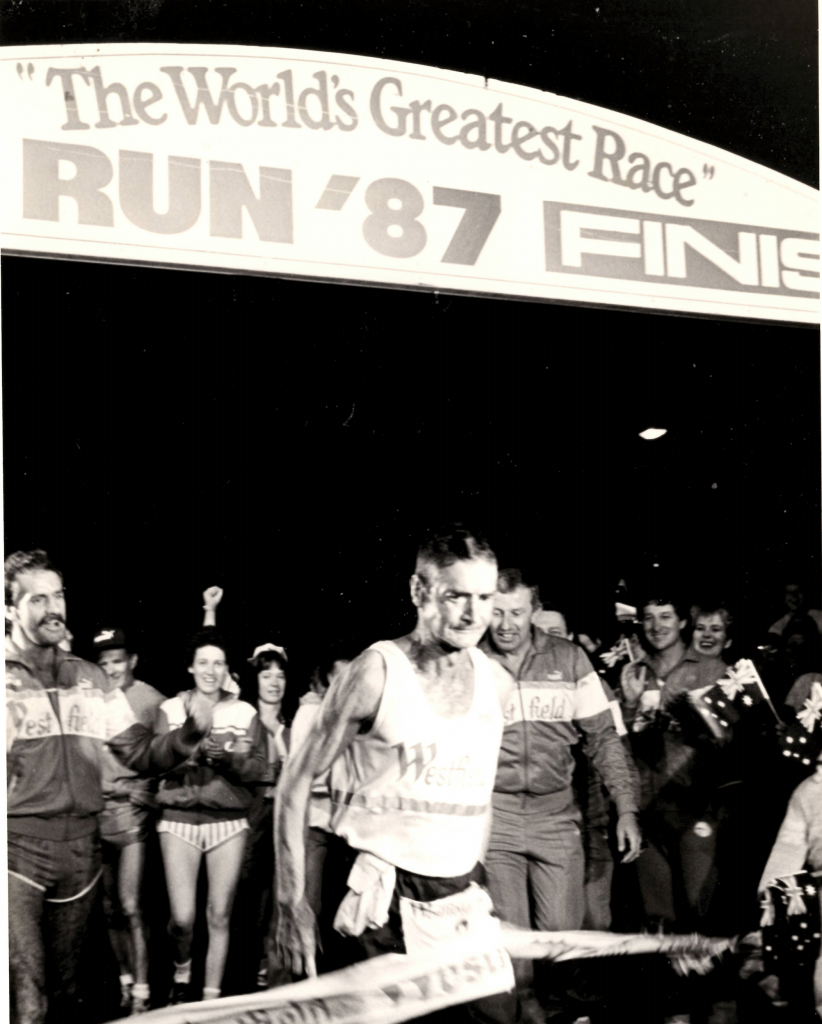
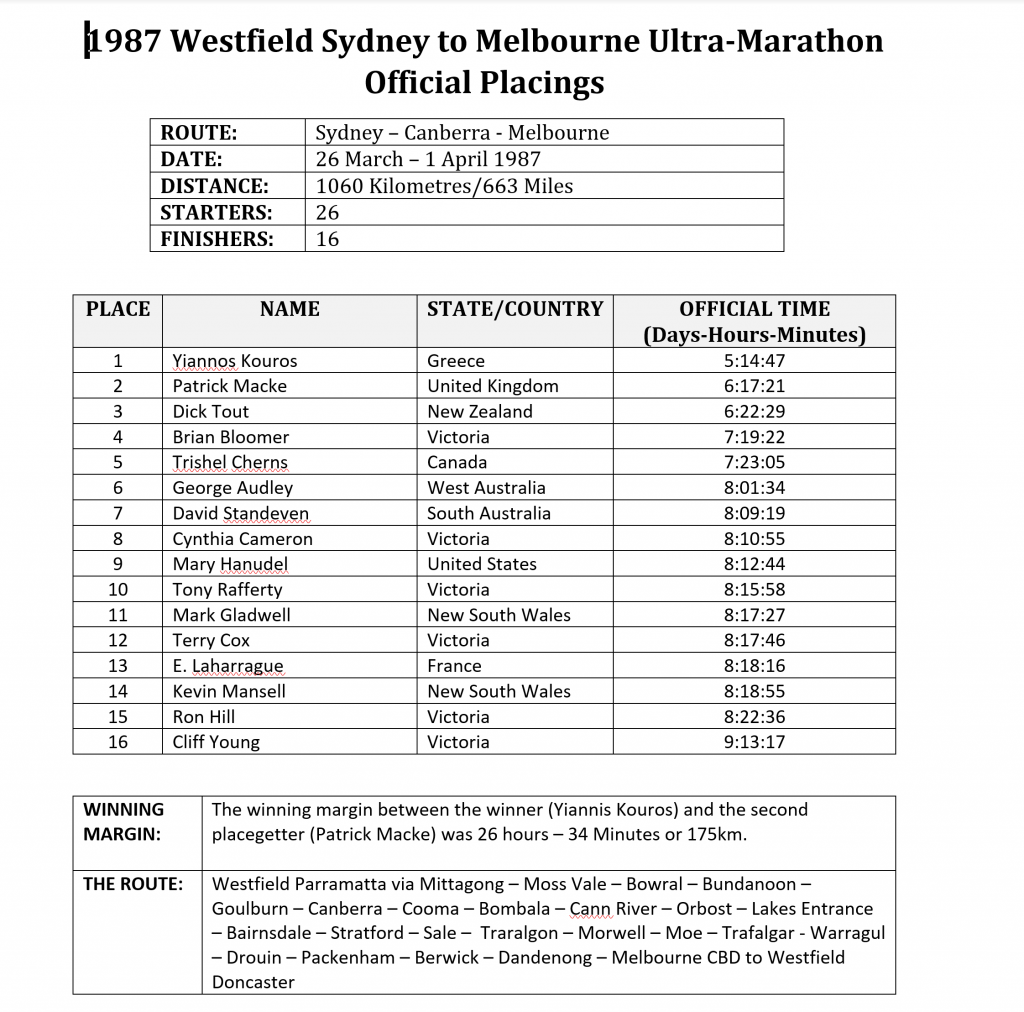
Yiannis Kouros: Post Race Interview with Race Director – Charlie Lynn
‘I knew I had to be careful. Because of the winter in Greece I had only 40 days training for the race. My toe was OK but my left ankle was swollen and my left knee was very sore. It sometimes locks into position and I thijnk I will need to have some surgery on it soon because it makes a lot of noise. It was also very hot so I planned to run carefully.
‘I meditate before every race and plan my run. This year I planned to run easy at the start. Some of the other runners went out very fast but it did not worry me. I do not notice other runners in this race. I just run my best according to my plan.
‘After 60 – 70 kilometres I started to feel good. I asked my crew to play some Greek music because I was now relaxed. When I got to Canberra I felt it was more easy than my last run. Maybe it was because I started slow this year. I was not sleepy but I stopped for 40 minutes to have a bath and some food. My masseur gave me a rub and I felt good.
‘The run to Cooma was more difficult because it was very hot in the afternoon. I did not feel very well. I think maybe I lost some salt and minerals in the heat. My legs were sunburnt and it hurt. The weather was a bigger problem for me than the hills. I felt better when it got cooler at night.
‘I arrive in Cooma after midnight and felt like a sleep. I rested for half-an-hour but couldn’t sleep so I started to run.
‘On Saturday I arrived in Bombala. Some Australian horsemen came to greet me and many children were waiting for me in the town. It made me feel good. I did not want to stop for long because I wanted to cross the gravel road near the border in daytime. I was afraid of this because I thought it would be a dangerous track like the Spartathalon course between Athens and Sparta in Greece. But it was a good road and I was happy. The countryside was beautiful and peaceful.
‘After I crossed the border I had my first sleep for about half-an-hour.
‘In Cann River the people gave me a boomerang. I stopped for a quick shower and then kept running. The rain came and it made the bush very fresh. I was in high spirits and asked for some music. I did some singing and some dancing along the road and felt almost as if I was detached from my body. I made good time through Orbost and Lakes Entrance.
‘In Sale the wind came and caused me some problems. I was spending too much energy running into it. I stopped early in the morning for a two-hour break.
‘The wind was still a problem all the next day. It slowed me down and I used up much energy trying to run against it but after Morwell I became so tired I could not run. I walked for about 7km but could not start running again. I was very tired and my eyelids kept shutting. I had to rest in Moe because I knew I could not go any longer. I had a massage, a hot bath and a meal. After this I had my best sleep. I did not wake for two hours.
‘In the morning I felt so good. I knew the race was behind me and I could run easy into Melbourne. I took a short stop in Hallam for a shower and a meal then I ran into the city.
‘My best memory of the race is seeing the big neon sign at Westfield Doncaster. When I saw it I asked my crew to put on a special song called ‘Old Tripolis’. It was composed by my grand-father who was a singer in our church. I had waited for this moment and when I heard it I ran faster, maybe 15 km/h. I could have run faster still because of the inspiration from the song. I sang the song and sometimes I skipped because I felt so happy. I was happy because I had run better than last time in 1985.
‘I will run even better next year because I now know the new road. I know I will improve.’
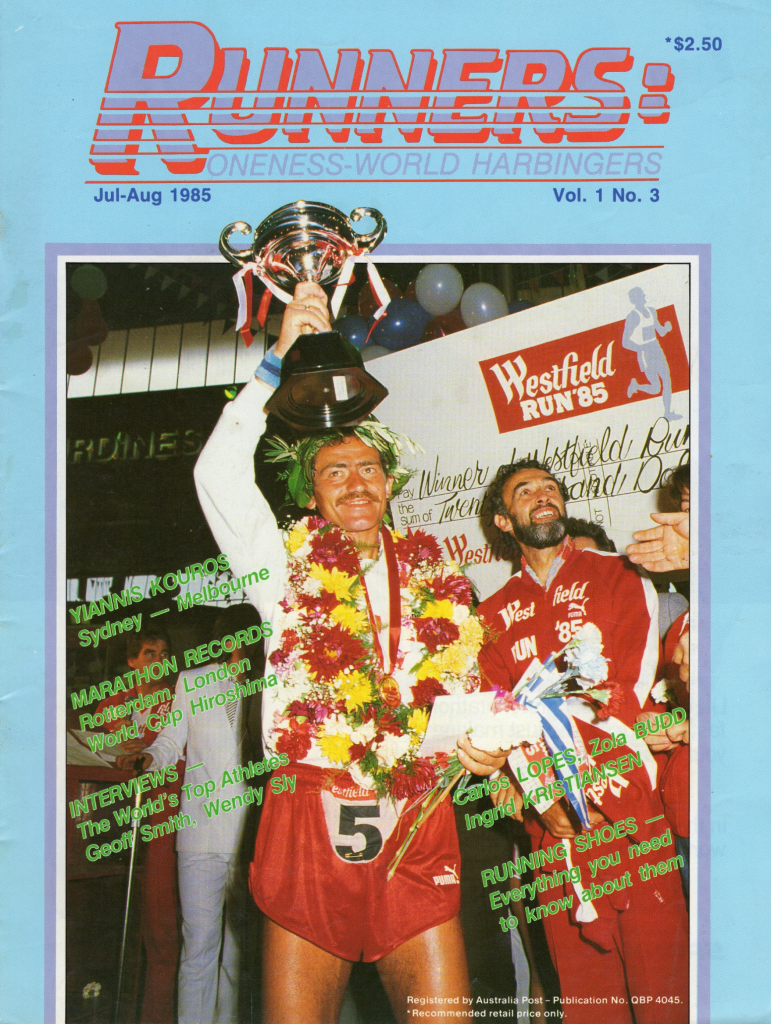
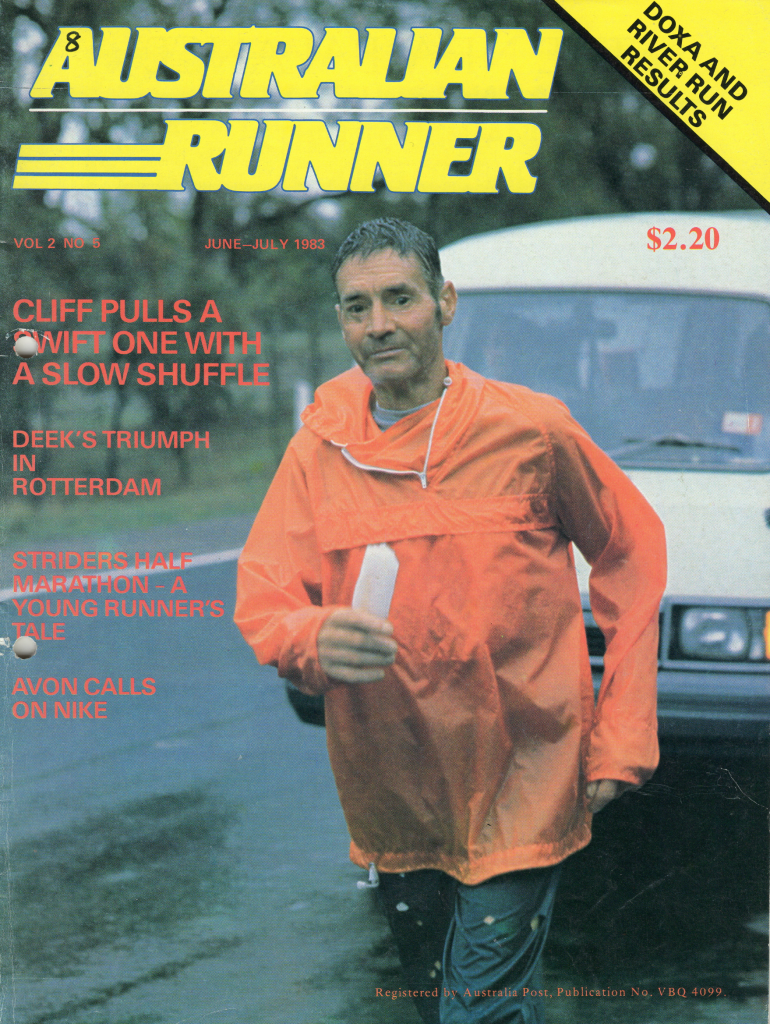
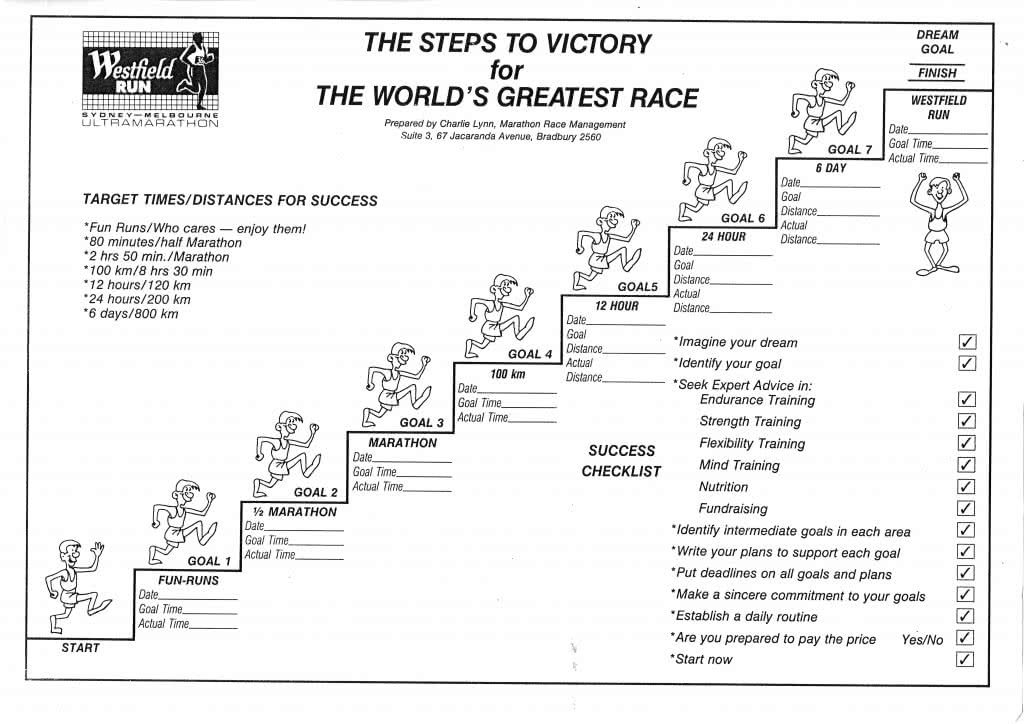
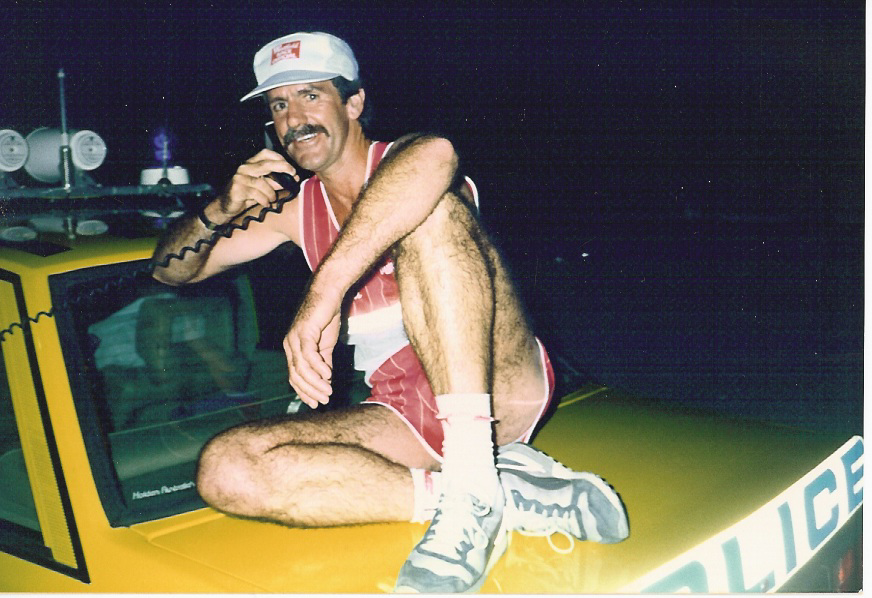


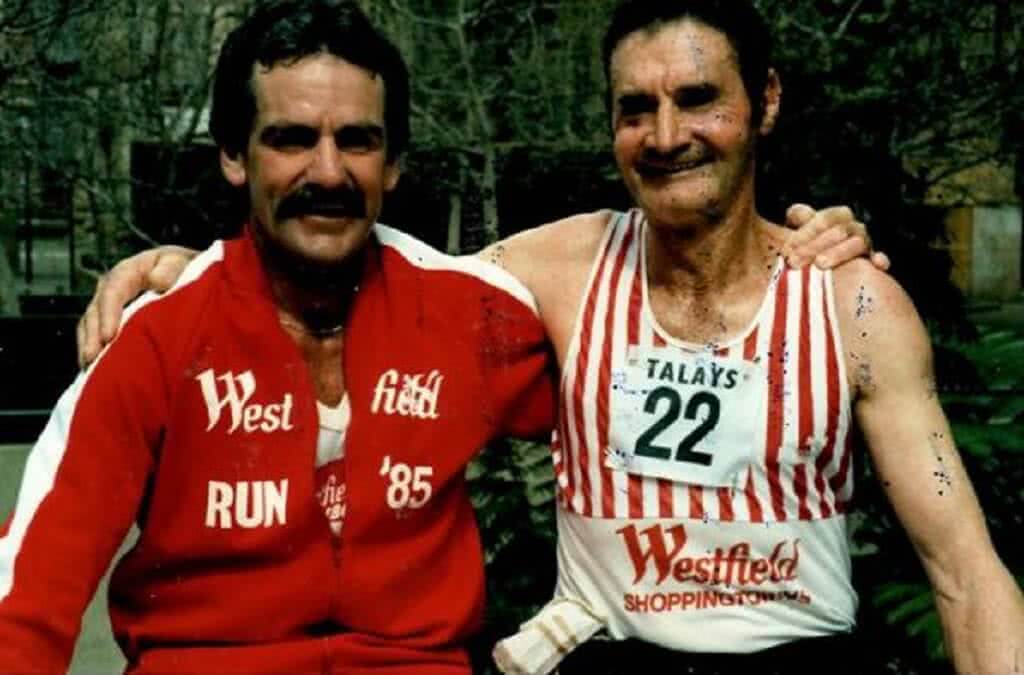



Hello Charlie and wonderful to find this and read it through. Unsure if you remember me but I had you address members of the Australian Institute of Credit Management a few times in the ’90’s and we both have a friendship with a good mate Harry Lamerton. Unsure if you know that Harry is very unwell. I came across this when researching history for a story I was putting together on My Life.
I will be in Sydney on the 21st to 23rd of this month and aim to try and see Harry at the nursing home he is in near Liverpool. I went on from a 6 year term with TNT Express and close association with the Australian Institute of Credit Management to start with DHL Express. I ended up as the Global Head of Collections for DHL having worked in Canada, the UAE, Africa and the USA. I returned to AU in 2014 and we now live at Gympie on a lovely 5 acre property. You were an inspiration in my life Charlie and I fondly remember our limited times together. I hope you are well? Are you still living in Camden? Would love to catch up for a cuppa when I am down there if you have time for an old admirer.
Great to hear from you Michael and I look forward to catching up when you are in Sydney – will email my details to you.